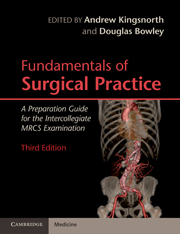Book contents
- Frontmatter
- Contents
- List of contributors
- Preface
- Section 1 Basic Sciences Relevant to Surgical Practice
- Section 2 Basic Surgical Skills
- Section 3 The Assessment and Management of the Surgical Patient
- Section 4 Perioperative Care of the Surgical Patient
- Section 5 Common Surgical Conditions
- 16 Assessment and early treatment of patients with trauma
- 17 Fundamentals of the central nervous system
- 18 Fundamentals of head and neck surgery
- 19 Fundamentals of thoracic surgery
- 20 Oesophago-gastric surgery
- 21 Fundamentals of hepatobiliary and pancreatic surgery
- 22 Fundamentals of endocrine surgery
- 23 Fundamentals of the breast
- 24 Lower gastrointestinal surgery
- 25 Fundamentals of the genitourinary system
- 26 Hernias
- 27 Fundamentals of vascular surgery
- 28 Fundamentals of orthopaedics
- 29 Fundamentals of plastic surgery
- 30 Surgical care of the paediatric patient
- 31 Fundamentals of organ transplantation
- Index
- References
21 - Fundamentals of hepatobiliary and pancreatic surgery
Published online by Cambridge University Press: 03 May 2011
- Frontmatter
- Contents
- List of contributors
- Preface
- Section 1 Basic Sciences Relevant to Surgical Practice
- Section 2 Basic Surgical Skills
- Section 3 The Assessment and Management of the Surgical Patient
- Section 4 Perioperative Care of the Surgical Patient
- Section 5 Common Surgical Conditions
- 16 Assessment and early treatment of patients with trauma
- 17 Fundamentals of the central nervous system
- 18 Fundamentals of head and neck surgery
- 19 Fundamentals of thoracic surgery
- 20 Oesophago-gastric surgery
- 21 Fundamentals of hepatobiliary and pancreatic surgery
- 22 Fundamentals of endocrine surgery
- 23 Fundamentals of the breast
- 24 Lower gastrointestinal surgery
- 25 Fundamentals of the genitourinary system
- 26 Hernias
- 27 Fundamentals of vascular surgery
- 28 Fundamentals of orthopaedics
- 29 Fundamentals of plastic surgery
- 30 Surgical care of the paediatric patient
- 31 Fundamentals of organ transplantation
- Index
- References
Summary
Liver
Segmental anatomy, blood supply and physiology
The adult human liver accounts for approximately 2% of body mass. Couinaud (1957) divided the liver into eight functionally independent segments. The middle hepatic vein divides the liver into a left hemiliver (segment 1 (caudate) and segments 2–4) and right hemiliver (segments 5–8). This ‘principal’ plane corresponds to an imaginary line joining the inferior vena cava and the gallbladder fossa. The right hepatic vein divides the right hemiliver into an anterior sector (segments 5, 8) and posterior sector (segments 6, 7). The left hepatic vein separates segment 2 (left lateral sector) from segments 3 and 4 (left medial sector). The portal vein divides the liver into upper and lower segments. Left and right portal vein branches project into the centre of each segment. Portal blood flow represents 65% of total liver perfusion but 50% of liver oxygen delivery, the remaining 50% being delivered via the hepatic artery.
The liver is a critical organ for detoxification as well as carbohydrate, protein and lipid metabolism. In addition to bile secretion, important functions include glycogen storage, haemoglobin degradation, plasma protein synthesis (including coagulation factors I (fibrinogen), II (prothrombin), V, VII, IX, X and XI, protein C and S), hormone production (insulin-like growth factor, thrombopoietin), vitamin and mineral storage (vitamin A, D, B12, iron, copper). The liver also has important immunological functions.
- Type
- Chapter
- Information
- Fundamentals of Surgical PracticeA Preparation Guide for the Intercollegiate MRCS Examination, pp. 358 - 377Publisher: Cambridge University PressPrint publication year: 2011



